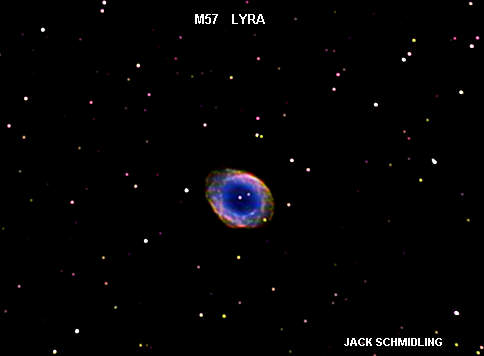M57, The Ring Nebula
Jack Schmidling Productions, Inc.18016 Church Road ~ Marengo IL 60152
| Telescopes | Galactic Photos | JSP Homepage |

The Ring Nebula
M57 is probably the most looked at and most photographed object in the sky. Much of it's popularity rests on the fact that it can be seen in almost any sized telescope. It's appearance as a tiny ring of smoke in a dark sky is a sight not soon forgotten.
The Ring belongs to a class of objects known as "planetary nebulae" which have nothing whatever to do with planets. They were called that back in the days of crude telescopes because their small disk shapes resembled planets and the name has stuck.
A planetary nebula is actually a large cloud of gas which was previously expelled from the central star. Having lost much mass to the cloud, the central star compresses to a very dense and hot star that illuminates the gas cloud via ultraviolet radiation in much the same way as electric current lights up neon in a sign.
.

The Ring Nebula
The Ring can be seen from early Summer to early Winter and is easy to locate. The contellation Lyra the Lyre includes Vega, the Westernmost star in the giant Summer Triangle. M57 is almost exactly between the two southern stars of Lyra.

This wide field photo is for context and shows the entire 2" field of the 4 x 5 camera on the 8", F5 telescope.
North is up and Beta Lyrae is the bright star on the right and Gamma on the left.
M57 is the non-descript white smudge between the two, in the center of the photo.
The three following images represent a progression of different telescopes and techniques. They were taken with the 8" (left) and the 10" (center) and 16" right. The 8 and 10 inch are photos on hypered Techpan film and the 16" is a CCD image. The 8" photo is actually an enlargement of the "context" photo above.



An amazing thing happened one night while experimenting with my new CCD camera. It was too late to do any serious imaging so I just pointed the scope at the Ring Nebula (M57) to see what my new CCD camera could do and I "discovered" a faint smudge just to the North of it in the same field. A quick study of the charts indicated that it was not a comet but a very faint galaxy that I had never noticed before. Even though the Ring is probably the most photographed object in the sky, it is so much brighter, that the galaxy is not visible in images optimized to bring out detail in M57.
The next night I set out to get a good image of the galaxy along with M57 in the same field for reference. I took a single 20 minute exposure and after processing it the next day, I went looking for other images but found nothing comparable until I got to the Palomar Schmidt photo (DSS). My joy was unbounded when I found star after star on my image that I could not see on the Palomar image.
It is truly mind boggling that a modest amateur telescope with the latest electronic technology can do today, what the greatest telescopes of only a decade or two ago could do. I invite you to compare the two images below. The only edge the Palomar image has is that it seems to be more sensitive to the emission wavelength of the halo around M57 than the CCD camera. I would also presume that something, no doubt has been lost, between the original plate and the DSS image.


It should be noted that seeing "star after star" is not is not for the casual observer. You might have to move the images off line to optimize the contrast and brightness for your particular viewer. Furthermore, it takes a trained eye to see the very faintest stars on images and make useful comparisons. Finally, my image was re-scaled smaller so the two images could be presented side by side on a web page for easy comparison and of course, both images have been compressed to save bandwidth. I have no clue as to why my image is brighter on the right side.
Just for references, the Ring lies at a distance of about 1500 light years and IC 1296 at about 320 million light years. It's a bit like lining your thumb up with a distant mountain.

And finally, the most recent picture taken with the MX7C color camera.
The color is quite a bit different from the picture at the top of the page and probably more closely represents the true colors.
Also note that IC1296 is visible in this image but not in the one taken with the MX5C.